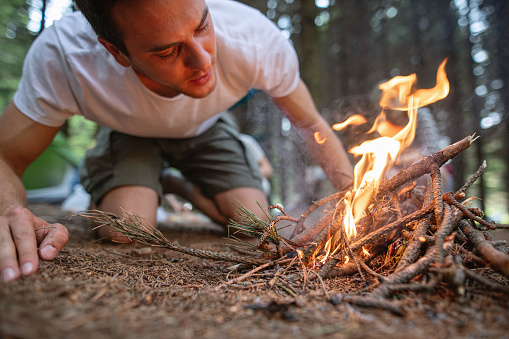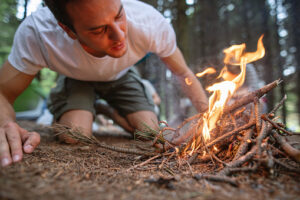Introduction
In a world that constantly throws challenges our way, having a robust survival plan isn’t just about preparation; it’s about ensuring our continued existence and thriving despite the odds. Let’s address a reality that most of us prefer to ignore: The world as we know it can change overnight. Whether due to natural disasters, economic collapse, or social upheaval, being unprepared is not an option.
The Harsh Reality of Modern Vulnerability
Imagine waking up one morning to find that the world has changed dramatically. The conveniences of modern life, the safety nets we rely on, and the predictability of our daily routines can disappear in an instant. Natural disasters such as hurricanes, earthquakes, and wildfires are becoming more frequent and severe. Economic instability, pandemics, and social unrest have shown us how fragile our systems can be.
The uncomfortable truth is that our society is more vulnerable than ever before. The illusion of security and stability can be shattered without warning, leaving us scrambling to survive. This isn’t manipulating through scare tactics; it’s a source of inspiration. Ignoring this reality can have dire consequences.
Achieving Self-Sufficiency and Resilience
Creating a survival plan isn’t just about preparing for worst-case scenarios; it’s about empowering yourself to live a more self-sufficient and resilient life. Here are the compelling benefits you can achieve:
- Peace of Mind: Knowing you have a plan in place can alleviate anxiety and fear. You’ll feel more confident and in control, no matter what happens.
- Self-Sufficiency: By learning survival skills, you’ll reduce your reliance on external systems. This means you can sustain yourself and your family even when resources are scarce.
- Physical and Mental Resilience: Preparing for survival builds physical strength and mental toughness. You’ll be better equipped to handle stress and adversity.
- Community Leadership: Your knowledge and preparedness can make you an asset to your community, helping others survive and thrive as well.
Step-by-Step Guide to Creating Your Final Survival Plan
1. Assess Your Risks
The first step in any survival plan is to assess the risks specific to your location and lifestyle. Consider the following:
- Natural Disasters: Are you in an area prone to hurricanes, earthquakes, floods, or wildfires?
- Economic Instability: How vulnerable is your local economy to downturns or job loss?
- Social Unrest: What is the political climate like, and are there potential risks of civil unrest?
- Pandemics: Are you prepared for another global health crisis?
By understanding the risks, you can tailor your survival plan to address the most likely scenarios.
2. Build a Survival Kit
A well-prepared survival kit is essential. It should include:
- Water: At least one gallon per person per day for at least three days.
- Food: Non-perishable items that can last for several weeks. Consider high-energy foods like nuts, dried fruits, and canned goods.
- Medical Supplies: First aid kit, prescription medications, and over-the-counter medicines.
- Tools and Equipment: Multi-tool, flashlight, batteries, matches, and a manual can opener.
- Clothing and Bedding: Weather-appropriate clothing, sturdy shoes, and blankets.
- Communication Devices: Battery-powered or hand-crank radio, and a fully charged power bank for your phone.
- Personal Documents: Copies of important documents like IDs, insurance policies, and bank information.
3. Develop a Communication Plan
In an emergency, staying in touch with loved ones and authorities is crucial. Your communication plan should include:
- Emergency Contacts: A list of phone numbers for family, friends, and local emergency services.
- Meeting Points: Pre-determined locations where you and your family can reunite if separated.
- Communication Methods: Understand how to use social media, apps, and traditional methods like walkie-talkies in case of cell service outages.
4. Learn Essential Survival Skills
Equip yourself with skills that can make a difference in a survival situation:
- First Aid and CPR: Basic medical knowledge can save lives.
- Fire Making: Learn how to start a fire without matches.
- Water Purification: Understand methods to purify water, such as boiling, filtration, and chemical treatment.
- Foraging and Hunting: Knowledge of edible plants and basic hunting skills can supplement your food supply.
- Self-Defense: Basic self-defense techniques can protect you from harm.
5. Secure Your Shelter
Your home is your primary shelter, but it may not always be safe. Prepare by:
- Reinforcing Your Home: Strengthen doors, windows, and roofs against natural disasters.
- Alternative Shelter: Identify safe locations where you can take refuge if you need to evacuate.
- Heating and Cooling: Ensure you have the means to stay warm or cool, depending on your climate.
Embracing the Power of Community
While personal preparation is crucial, the unexpected power of community cannot be overstated. In times of crisis, communities that band together are more likely to survive and recover. Here’s why:
- Shared Resources: Pooling resources can ensure that everyone has access to essentials like food, water, and medical supplies.
- Skill Sharing: Different people have different skills. A community with diverse talents can address various challenges more effectively.
- Emotional Support: Surviving a crisis can be mentally and emotionally taxing. A supportive community can provide the necessary emotional strength.
- Security: A united community can better defend against threats and maintain order.
Building a Strong Community Network
To harness the power of community, start building your network now:
- Get to Know Your Neighbors: Establish relationships with those living nearby. Exchange contact information and discuss emergency plans.
- Join Local Groups: Participate in community groups focused on preparedness, such as neighborhood watch programs or local survivalist clubs.
- Volunteer: Engage in local volunteer efforts to build trust and rapport with your community.
- Host Workshops: Share your knowledge by organizing workshops on survival skills and emergency preparedness.
Conclusion: Act Now
The Final Survival Plan isn’t just about preparing for the worst; it’s about empowering yourself to live a more resilient, self-sufficient life. The harsh reality of our modern vulnerabilities demands that we act now. By addressing these risks, creating a solid survival plan, and building a strong community network, you can ensure that you and your loved ones are prepared for whatever the future holds.
Try not to trust that everything will go south before you make a move. Start today and embrace the peace of mind and confidence that comes with being truly prepared. Your future self will thank you. Click here to find more.














